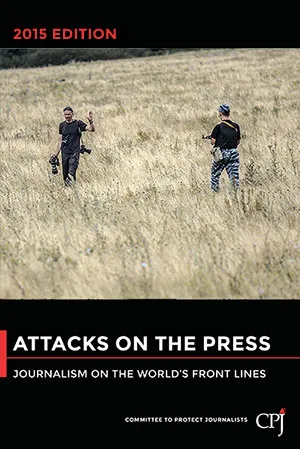In Pakistan, an unknown gunman shoots a news anchor multiple times. No one is arrested for the crime, though arrest warrants are issued against the journalist–for his reporting.
In Paraguay, a journalist goes into hiding, with bodyguards armed with submachine guns, because of threats to his life made by a smuggling cartel unhappy with his reporting.
In Egypt, three journalists spend a year in prison after being arrested in their Cairo hotel room by a government that disapproves of their coverage of the military’s seizing power.
In Greece, two photojournalists are attacked by right-wing militants outside an Athens courthouse, simply for being there, covering the news.
Somewhere in the Syrian desert, two journalists are brutally executed, not for their reporting but to gain attention for the terrorists who kill them.
And in Paris, eight journalists with the satirical magazine Charlie Hebdo are murdered in a terrorist attack by two gunmen who were reportedly angry over the magazine’s portrayal of the Prophet Muhammad.
Such are the kinds of dangers journalists face around the globe. From government surveillance and censorship to computer hacking, from physical attacks to imprisonment, kidnapping, and murder, the aim is to limit or otherwise control the flow of information–an increasingly complicated effort, with higher and higher stakes.
In November 2014, when the Committee to Protect Journalists held its annual International Press Freedom Awards event in New York City, which I had the honor of hosting, John and Diane Foley took to the podium to address the beheading of their son, journalist Jim Foley, by ISIS the preceding August. The Foleys voiced the shared anguish of family, friends, and journalists over one of the most horrific and visible crimes against journalists in a year that brought far too many of them. As if we needed a reminder that true evil exists in the world, ISIS provided one. Along with Jim and fellow journalist Steven Sotloff, ISIS also beheaded countless civilians, children, and captive soldiers. Other journalists were murdered, killed, or kidnapped elsewhere, in many cases without news coverage or publicity.
It would be terrible enough if the tragedies that befell journalists in 2014 had been isolated episodes–if we could write the year off as a nightmare and move on. But with well over 1,000 journalists having been killed since 1992, and with the deadly attack on Charlie Hebdo early in 2015, it is clear that the threats are not limited to bad years, nor are they going away. The dangers the Foleys addressed, like those explored in these pages, transcend calendar years and international boundaries. They are expanding in seemingly every direction, morphing in new and disturbing ways. At stake are not only journalists’ lives but also the public’s ability to know what’s going on around them.
Conflict reporting has always been a risky endeavor, and it is becoming more so in an era of widespread political turmoil and rapid transmission of information through electronic technology, particularly social media. One reason the ISIS murders strike a chord is their high visibility: The group has repurposed one of the most archaic and gruesome forms of execution for the Internet age, with videos of its beheadings distributed like news releases on the Web.
Though the highly publicized beheadings of Western journalists have brought the risks home to a public that may not have fully grasped what is at stake, countless other journalists have been compromised, attacked, harassed, kidnapped, imprisoned, or killed, often with scant public awareness. The majority are freelancers, who tend to have limited funding and training and, often, no established media outlet to fully support them. Freelancers are increasingly crucial to global reporting, and the broadest array of threats is aimed at them.
From cybersecurity to physical safety, the challenges facing journalists today are more complex than ever, and they come from familiar hot spots such as the Middle East, Africa, and Latin America as well as from comparatively stable countries in Europe, Asia, and North America. In some cases, such as in South Africa, hard-won press freedoms are under siege by an establishment that seeks to shield itself from the gaze of a thriving investigative press, which is the subject of an essay in this anthology by Ferial Haffajee, who, along with three fellow journalists–Iranian Siamak Ghaderi, Russian Mikhail Zygar, and Myanmarese Aung Zaw–received CPJ’s 2014 International Press Freedom Award.
Also included here are reports about journalists’ needs for better personal safety and electronic security measures; about how new legal restrictions, particularly in the Middle East, seek to constrain online media outlets that are often the public’s only source of independent news; and about how the Western world is adapting–in very different ways–to the pervasiveness of online information.
Each story is a cautionary tale. Taken as a whole, they illustrate that vigilance has never been more crucial, or more difficult, for the free press around the world. The greatest threat isn’t to one or two individuals, nor is it confined to any given country or year. An information battle is under way worldwide, and it is evolving in extremely dangerous ways. The one constant, as always, is that reporters are on the front line.
Christiane Amanpour is chief international correspondent and host of CNN International’s “Amanpour,” a nightly global affairs program. She is a member of CPJ’s board of directors.
EDITOR’S NOTE: The first paragraph has been corrected to reflect that arrest warrants were issued against the journalist in connection with his reporting.
